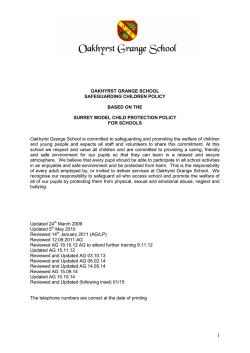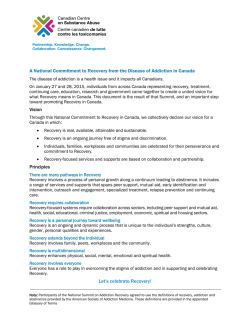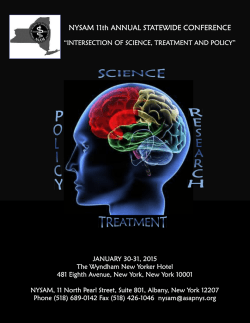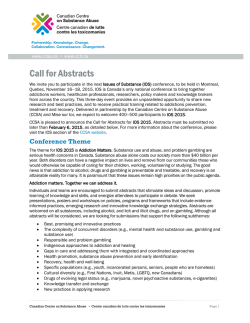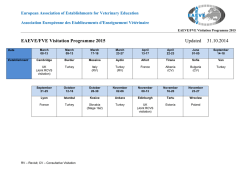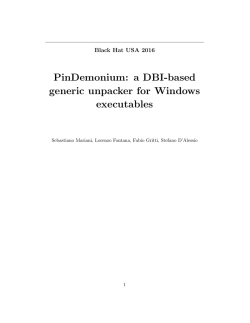
Internet Abuse among Teenagers and Its Relations to Internet
Gencer, S. L., & Koc, M. (2012). Internet Abuse among Teenagers and Its Relations to Internet Usage Patterns and Demographics. Educational Technology & Society, 15 (2), 25–36. Internet Abuse among Teenagers and Its Relations to Internet Usage Patterns and Demographics Suzan Lema Gencer and Mustafa Koc Department of Educational Technology, Suleyman Demirel University, 32260, Isparta, Turkey // [email protected] // [email protected] ABSTRACT This study focused on exploring Internet abuse among teenagers and its relations to some Internet usage patterns and demographic characteristics in a digitalizing country, Turkey. It was designed as a cross–sectional research on three types of school that differ in their academic performances. The data were collected from 1380 high school students through a paper–based questionnaire. The results identified a small portion of students as Internet abusers experiencing severe problems and one fourth as possible abusers experiencing occasional problems in their lives. Excessive use, tolerance, preoccupation with the Internet, and using the Internet to escape from negative feelings were the most frequently reported symptoms of disturbed patterns of online behaviors. One–way between–groups ANOVA tests revealed that Internet abuse differed significantly based on gender and perceived academic achievement with small effect sizes, and frequency of Internet use, dominant place of Internet use and dominant purpose for Internet use with medium and large effect sizes. On the contrary, no significant differences were found based on perceived socio–economic status and the type of school attended. Keywords Internet abuse, High school students, Usage patterns, Demographics, Turkey Introduction Internet access and usage in the world has been proliferating year by year, with approximately 1.11 billion users in 2007, 1.67 billion in 2009, and 1.97 billion in 2010 (Miniwatts Marketing Group, 2010), indicating an upward trend in the number of digitally literate people. Such a rapid growth has been interacted with people’s needs and motivation. Information, communication, and entertainment have been prominent motives behind the Internet use. The advantages of the Internet are undeniable and well–evidenced in the literature. Nevertheless, excessive or unregulated usage has been associated with a condition of Internet–related disturbances which Morahan–Martin (2008) calls “Internet abuse” referring to the “patterns of using the Internet that result in disturbances in a person’s life but does not imply a specific disease process or addictive behavior” (p. 34). Some scholars or clinicians prefer to use the term “Internet addiction” to define this condition as a form of impulse control disorder (e.g., Young, 1998). Despite various approaches to the conceptualization of the condition, which is still developing and negotiated in ongoing research, studies acknowledged its existence and reported similar symptoms: school and work–related impairments, interpersonal problems, preoccupation with using the Internet, using the Internet to improve negative moods, and serious disturbances in users’ social capitals (Morahan–Martin, 2008). The present study adopted the concept of Internet abuse because it examined the condition in a non–pathological population and operationalized the Internet behavior as a continuum from normal to problematic usage. Nowadays, the adoption of digital technologies is known to be higher in young adolescents than adults. For example, the highest proportion of computer and Internet usage belongs to the 16–24 year old age group in Turkey (TUIK, 2010), where Internet users aged 15 and older were reported as the most engaged users in Europe in terms of time spent and the content consumed on the Internet (comScore, 2009). Being the mainstream consumers and drivers of digital contents, youngsters are at the center of a lucrative digital marketing enterprise. New products are designed essentially for appealing to emotions, habits, and values in youth culture (Montgomery, Gottlieb–Robles & Larson, 2004). This in turn makes young people early adopters and heavy users of digital technologies. Such an involvement, coupled with the psychologically sensitive developments of adolescence period, can make teenagers more susceptible to digital disturbances such as Internet abuse (Chou, Condron & Belland, 2005; Tsai & Lin, 2003). Therefore, empirical investigations of factors in problematic Internet use among teenagers have been called for to help parents, teachers, and counselors in guiding teenagers about the conscious and beneficial effects of Internet use. This study attempted to contribute to this call by exploring possible interactions between Turkish high school students’ status of Internet abuse, Internet usage patterns, and demographic characteristics. ISSN 1436-4522 (online) and 1176-3647 (print). © International Forum of Educational Technology & Society (IFETS). The authors and the forum jointly retain the copyright of the articles. Permission to make digital or hard copies of part or all of this work for personal or classroom use is granted without fee provided that copies are not made or distributed for profit or commercial advantage and that copies bear the full citation on the first page. Copyrights for components of this work owned by others than IFETS must be honoured. Abstracting with credit is permitted. To copy otherwise, to republish, to post on servers, or to redistribute to lists, requires prior specific permission and/or a fee. Request permissions from the editors at [email protected]. 25 Although prior research on overall analysis of Internet abuse is prolific, the research on socio–demographic differences in this field is rather sparse or inconclusive. Gender is one of the predominantly investigated variables seen in the literature. While some studies indicated no gender differences in Internet abuse (e.g., Ferraro, Caci, D’amico & Blasi, 2007; Lee et al., 2007; Soule, Shall & Kleen, 2003), others revealed that males were more likely to become Internet abusers than females (e.g., Chou et al., 2005; Morahan–Martin & Schumacher, 2000; Yang & Tung, 2007). Although socio–economic status (SES) is an important factor especially in the developing countries, where digital divide still exists to some degree, not much attention has been devoted to this demographic variable. Only a few studies concluded that SES was not significantly associated with Internet abuse (e.g., Cakir–Balta & Horzum, 2008; Yoo et al., 2004). More systematic research is needed to clarify the role of gender and SES in problematic Internet use. Furthermore, increased availability of Internet access in educational environments has raised the recent question of whether disturbed Internet usage can be related to some academic variables. For example, the level of Internet abuse may be dependent on the schools that differ in terms of student motivation and academic achievement. School culture may also contribute to online behaviors. Perhaps, teachers, managers, or schoolmates socially encourage and reward students’ Internet usage. Empirical research is needed to examine school–related variables. Bayraktar and Gun (2007) found that secondary and high school students’ grade point averages decreased as their disturbed use of the Internet increased. Yang and Tung (2007) found that the likelihood of Internet abuse was higher for vocational high school students compared to other high school students. However, such research is very limited to make conclusive interpretations. On the other hand, a growing body of research has investigated what kinds of Internet use are associated with Internet abuse. In particular, the amount of Internet use has been persistently explored in the literature. While it has been found to be positively associated with Internet abuse, the findings differentiated in terms of average time spent online by Internet abusers (Cakir–Balta & Horzum, 2008; Chou & Hsiao, 2000; Morahan–Martin & Schumacher, 2000; Young, 1998). Therefore, further research with different measures of Internet use (e.g., frequency) is suggested to solidify the validity of previous findings. Moreover, there are other key usage patterns that may interact with disturbed Internet use. One of them could be the type of activities engaged on the Internet. Prior research indicated that Internet abusers often preferred interactive online activities such as chatting and playing online games (Chen, Tarn & Han, 2004; Young 1998). Such research should continue in different population and time periods because online behaviors may change according to both user characteristics (e.g., age, occupation, cultural identity) and new applications that will be added on the Internet. Yet another usage pattern is the place of Internet use. Young users usually share Internet access with others at their home and schools. This may lead to a limited amount of usage. Having watched by family members, teachers, and peers can also make youngsters feel uncomfortable and thus seek alternative places. There are some commercial places (e.g., cybercafes) that provide somewhat unrestricted Internet access at a reasonable cost. Such places also function as a popular entertainment and socialization outlet for youngsters because they can gather and use the Internet together (e.g., playing multi–user games). Research demonstrated that cybercafes covered 20% of recent Internet usage in Turkey (TUIK, 2010) and more than half of their clients were teenagers (Gurol & Sevindik, 2007). Another study on Turkish students aged 12 to 18 showed that most (72.4%) went to cybercafes and frequent visitors were more likely to be problematic Internet users than rare visitors (Tahiroglu, Celik, Uzel, Ozcan, & Avci, 2008). Although limited number of studies indicated home usage as an important factor in Internet abuse (e.g., Johansson & Gotestam, 2004), further research is needed to determine the associations of various places with Internet usage. Purpose of the study The purpose of this cross–sectional study was to explore the status of Internet abuse among 15–18 years old Turkish high school students and its relationship to their Internet use patterns and demographic characteristics. As indicated in the previous section, similar studies exist in the literature, but they are inconclusive and most focus on the developed and highly–digitalized countries that may differ in certain respects. Beard (2005) maintains that disturbed Internet use may differ by a number of socio–cultural factors including, but not limited to, family conflict, peer modeling, expectations of the society, Internet penetration rate, lack of certain social skills, cultural orientation, and value beliefs about the Internet. More research is needed to examine which variables are related to Internet abuse. Therefore, the present study attempts to enhance related literature by presenting data about some rarely examined usage variables (e.g., place of Internet use), beyond the usual demographics (e.g., school type), and from a culturally distinct developing country, Turkey. The study was guided by the following research questions: 26 1. 2. 3. 4. How do Turkish high school students’ Internet usage patterns (i.e., frequency of use, dominant place of use, and dominant purpose of use) distribute? What is the status of Internet abuse among these students? Are there differences in Internet abuse based on demographics (i.e., gender, perceived SES, school type, and perceived academic achievement)? Are there differences in Internet abuse and Internet usage patterns? Research methodology Participants Cluster sampling was employed to recruit the participants from the population of high school students in 20 schools in the city of Isparta, Turkey. Since school type was used as a grouping variable in the study, the schools were clustered into three groups: vocational (n=8), general (n=4), and Anatolian schools (n=8). This order also represents the ascending order of average students’ motivation and achievement in these schools. In accordance with the research budget and time constraints, a total of five schools were proportionally (i.e., 40%, 20%, and 40% respectively) and randomly selected from the three groups. Therefore, the final sample was made up of 1380 students who were accessible and volunteer at the time of the data collection. Demographic characteristics of the sample are given in the following results section. Procedures and instruments The data were gathered through a paper–based questionnaire towards the end of the fall semester in 2010. In order to ensure the content validity of the instrument, all questions were derived from the relevant literature. Moreover, the questionnaire was reviewed by two educators to ensure the face validity. The approval for the survey administration was granted by the Provincial Office of National Education in the city of Isparta. The first author visited schools and conducted the survey in two weeks. Students were not offered any incentives and their anonymity was assured by not requesting any identifying information. The questionnaire form comprised three main sections. The first section contained several multiple–choice items that asked students to provide the following background information: gender (male, female), type of the school they were attending (vocational, general, and Anatolian), perceived SES of their family (low, middle, and high class), and perceived academic achievement (poor, average, and good). In the second section, students were asked to provide information about their Internet usage. The frequency of Internet usage was measured by a four–point Likert scale item ranging from “not at all” to “everyday”. The dominant place of the usage was measured through a multiple–choice item with single response and “other” option that asked students to indicate the place where they most frequently access to the Internet. The related literature revealed four main motives for Internet use as: information (e.g., searching for information, doing assignments, reading news), communication (e.g., using e–mail, instant messaging), entertainment (e.g., playing games, watching videos), and business (e.g., online shopping, trading) (Koc & Ferneding, 2007). Hence, the dominant purpose of usage was operationalized on a multiple–choice item with these four options asking students to select only the one for which they most frequently use the Internet. The last section contained “Internet Addiction Test” (IAT) that was developed by Young (1998) as one of the first standardized tests for the assessment of disturbed Internet use. Although there are several instruments available in the literature, the IAT was selected for this study because it had already been adapted into Turkish by Bayraktar (2001). It was also shown to produce valid and reliable measures in several studies on Turkish youth (e.g., Bayraktar, 2001; Cakir–Balta & Horzum, 2008). The test contains 20 items which ask respondents to rate how often they show such symptoms of damaging Internet usage as excessive time spent online, neglect of daily routine tasks, disruption of academic or job performance, concealment of online time and behaviors from others, loss of sleep, social isolation, depressive feelings if usage is restricted, and failure attempts to cut down Internet use (Table 2). It employs a six– point Likert scale ranging from “0=never” to “5=always.” Thus, the possible total score for each respondent could range from 0 to 100, with higher scores indicating greater problems associated with Internet usage. In accordance with Young’s (1998) grouping criteria based on the normative cut–off scores, the present study classified students 27 with a score of 39 and below as “average user”, those with a score of 40 to 69 as “possible Internet abuser”, and those with a score of 70 and above as “Internet abuser”. Prior psychometric studies of Internet abuse have indicated that the IAT is a valid and reliable instrument (e.g., Widyanto & McMurran, 2004). Nevertheless, a confirmatory factor analysis using structural equation modeling on LISREL 8.80 software program was conducted to verify the single–factor structure of the IAT for the present data set. This analysis was based on a covariance matrix and maximum likelihood estimation. Since chi–square value is known to be inflated and significant with large sample size, other goodness–of–fit indices including Comparative Fit Index (CFI), Normed Fit Index (NFI), Goodness of Fit Index (GFI), Root Mean Square Error of Approximation (RMSEA) and Root Mean Square Residual (RMR), which are less sensitive to sample size, were used to assess the fitness of the single–factor model. The results revealed that standardized factor loadings of the items were all meaningful in size, ranging from .43 to .69. The t–test values for these loadings ranged from 15.73 to 27.44 and were statistically significant (p<.01), indicating that Internet abuse significantly explained all items of the IAT. The goodness–of–fit measures (CFI=.96, NFI=.96, GFI=.91, RMSEA=.072, RMR=.055) indicated that single–factor model had an acceptable fit for the present data. Furthermore, the reliability of the model was checked by computing Cronbach alpha internal consistency coefficient. The coefficient was found .91, which indicated that the IAT produced very reliable measures. Data analysis The questionnaires were initially coded in order to quantify the items. Next, all the data were entered to Statistical Package for the Social Sciences (SPSS 17). Then, they were subjected to frequency and percentage analyses in order to check for possible errors made during the data entrance. This also helped to describe the variables. Measures of central tendency and variability were calculated for the scores obtained from IAT items. Finally, a series of one–way between–groups analysis of variance (ANOVA) with post hoc tests were conducted to find out whether there were significant differences in the mean scores of total IAT scores (dependent variable) across the levels of demographical and Internet usage variables (independent variables) included in the study. Partial Eta–squared (η2) and Cohen’s d statistics were also calculated to estimate effect sizes (i.e., strength of relationships) for the overall ANOVA tests and follow–up post–hoc comparisons respectively. Results Demographic Characteristics of the Sample Due to the use of cluster sampling, the sample distribution of school type was very similar to the one in the population: 39% vocational, 23% general, and 38% Anatolian high school. Regarding gender breakdown of the participants, the proportion of females (56%) was larger than those of males (44%). When asked about the SES, the majority of the students (86%) perceived their family as middle class while the remaining evenly divided between low (7%) and high (7%) class. As far as academic achievement was concerned, students with a perception of average school performance were the largest group (64%), followed by those with a perception of good (25%) and poor (11%) school performance. Internet usage patterns Table 1 presents Internet usage patterns and their categories with respective percentages. In terms of the frequency of use, almost one third (30.8%) used the Internet every day, just less than half (45.5%) used it a few times a week, and one fifth (20.1%) used it a few times a month. Only 3.6% of the students reported that they had never used the Internet. Therefore, most of them (76.3%) were at least weekly users. More than half of the users (63.8%) reported “home”, one quarter (25%) reported “cybercafés,” and a small proportion (5.4%) reported “school” as their dominant place of Internet use. Moreover, a tiny proportion (5.8%) specified other places that included workplace, friends’, relatives’, and neighbors’ houses. When asked about the purpose for which they mostly use the Internet, 39.2%, 30.6%, and 29.7% indicated communication, information, and entertainment respectively. The remaining, less than one percent, reported using the Internet mostly for business purposes. 28 Table 1. Frequency distribution of students’ internet usage patterns Pattern / category Frequency (f) Frequency of Internet use Never 50 A few times a month 276 A few times a week 627 Everyday 424 Total 1377 Dominant place of Internet use Home 846 Cybercafe 332 School 72 Other places 77 Total 1327 Dominant purpose for Internet use Information 406 Communication 521 Entertainment 394 Business 7 Total 1328 Percentage (%) 3.6 20.1 45.5 30.8 100 63.8 25 5.4 5.8 100 30.6 39.2 29.7 .5 100 The Status of Internet Abuse The total IAT scores ranged from 20 to 100 with a mean score of 34.32 (SD=13.57). Most students (73%) were identified as average users (AUs) with a mean score of 27.56 (SD=5.32), who have control over their Internet usage. Almost one quarter (24.3%) were classified as possible Internet abusers (PIAs) with a mean score of 49.48 (SD=7.89), who experience occasional or frequent problems in their lives. The remaining fraction (2.7%) was diagnosed as Internet abusers (IAs) with a mean score of 80.16 (SD=8.92), who suffer significant problems from their usage. It can be said that a little more than one fourth (27%) appear to experience some problems with Internet use. Table 2. Descriptive statistics for the symptoms of Internet abuse AUs PIAs Symptom Mean SD Mean SD Stay online longer than intended 1.89 .92 3.45 1.34 Getting impatient to go online 1.36 .73 2.88 1.48 Craving more time to be online 1.50 .87 3.25 1.45 Going online to block disturbed thoughts 1.76 .92 3.08 1.37 Feeling restless when not being online 1.16 .54 2.16 1.38 Getting complaints about time spent online 1.40 .81 2.89 1.49 Think of life as boring without the Internet 1.63 1.02 3.00 1.53 Fantasy of being online when offline 1.22 .53 2.32 1.31 Checking e–mails before anything else 1.95 1.19 3.19 1.58 Loss of sleep 1.19 .54 2.31 1.42 Neglect of household chores 1.25 .51 2.12 1.09 Getting annoyed when bothered online 1.50 .97 2.53 1.39 Forming new online relationships 1.40 .78 2.30 1.35 Negative effect on school performance 1.17 .48 2.01 1.16 Lowered productivity 1.20 .54 2.07 1.24 Withdrawing from other pleasurable activities 1.12 .42 1.92 1.27 Failed attempts to reduce time spent online 1.33 .76 2.31 1.35 Guilt about Internet usage 1.28 .69 2.25 1.35 Deception about time spent online 1.10 .41 1.85 1.20 Social estrangement 1.13 .40 1.59 .93 Note. AUs=Average users; PIAs=Possible Internet abusers; IAs=Internet abusers. IAs Mean 4.67 4.58 4.56 4.53 4.36 4.31 4.28 4.28 4.22 4.22 3.92 3.89 3.85 3.81 3.72 3.64 3.61 3.39 3.33 3.00 SD .79 .77 .91 .99 1.07 1.24 1.34 1.06 .99 1.20 1.27 1.28 1.35 1.35 1.52 1.46 1.57 1.57 1.60 1.57 29 Table 2 demonstrates mean scores and standard deviations for the symptoms of Internet abuse measured by the IAT index for each of three groups. It prioritizes these symptoms in order of severity in the IAs. As expected due to the use of normative cut–off scores, the mean scores for each symptom increased across the groups from AUs to IAs. The most frequently reported symptoms among the IAs are related to excessive use, tolerance, preoccupation with the Internet, and using the Internet to escape from negative feelings. Similar symptoms were also reported most frequently among the PIAs. Social estrangement was the least frequently reported symptom in both PIAs and IAs. The role of demographics in Internet abuse Table 3 presents the number of subjects, mean scores, and standard deviations for all levels of each demographic variable. Table 4 shows one–way between–groups ANOVA results for the comparisons of IAT scores across the demographics. There was a significant difference with a small effect size in IAT scores based on gender {F(1, 1326)=30.32, p<.01, partial η2=.02}. Since the homogeneity of variance assumption was violated, Brown–Forsythe correction were applied and it confirmed the significant difference {F(1, 1135.08)=29.05, p<.01}. Male students reported significantly higher mean scores than female students. Besides, the IAT scores differed significantly based on perceived academic achievement {F(2, 1319)=22.81, p<.01}. The effect size was small (partial η2=.03). Again, due to the heterogeneity of the variances, Brown–Forsythe correction confirmed the significant difference {F(2, 384.46)=17.95, p<.01}. Follow–up post–hoc comparisons using Dunnett’s C test indicated that poor achievers had significantly higher mean scores than both average (p<.01, Cohen’s d=.42) and good achievers (p<0.01, Cohen’s d=0.58). On the other hand, there were no significant differences based on school type {F(2, 1325)=0.64, p>0.05} and perceived SES {F(2, 1324)=2.98, p>0.05}. Table 3. Descriptive statistics for Internet abuse by demographics Demographic / Level N Mean Gender Female 738 32.51 Male 590 36.59 School type General 303 33.56 Vocational 515 34.63 Anatolian 510 34.46 Perceived socio–economic status Low 79 32.84 Middle 1156 34.18 High 92 37.45 Perceived academic achievement Poor 153 40.60 Average 850 34.13 Good 319 31.77 Table 4. One–way ANOVA results for differences based on demographics Demographic variable Source Sum of Squares df Mean Squares Gender Between groups 5461.51 1 5461.51 Within groups 238867.30 1326 180.14 Total 244328.81 1327 School type Between groups 236.42 2 118.21 Within groups 244092.40 1325 184.22 Total 244328.82 1327 Perceived socio–economic status Between groups 1094.76 2 547.38 Within groups 243127.50 1324 183.63 Total 244222.30 1326 Perceived academic achievement Between groups 8138.41 2 4069.21 Within groups 235353.40 1319 178.43 Total 243491.81 1321 *p<0.01 SD 12.20 14.80 13.76 13.23 13.80 12.80 13.23 17.51 17.49 12.87 12.87 F–value 30.32* 0.64 2.98 22.81* 30 The role of usage patterns in Internet abuse Similar ANOVA tests were repeated to determine whether Internet abuse significantly differed across the levels of Internet usage patterns. Table 5 illustrates the number of subjects, mean scores, and standard deviations for all levels and Table 6 summarizes the results of ANOVA analyses. There was a significant difference with a large effect size in IAT scores based on the frequency of Internet use {F(2, 1324)=167.84, p<.01, partial η2=.20}. Brown–Forsythe correction {F(2, 904.77)=169.44, p<.01} was calculated to confirm this finding because of the heterogeneity of variances. Analysis of post hoc comparisons via Dunnett’s C test revealed that the IAT scores of daily users were significantly higher than those of weekly (p<.01, Cohen’s d=.84) and monthly users (p<.01, Cohen’s d=1.20), and that the IAT scores of weekly users were significantly higher than those of monthly users (p<.01, Cohen’s d=.46). Moreover, the IAT scores significantly differed with a small to medium effect size based on the dominant place of Internet access {F(3, 1323)=22.86, p<.01, partial η2=.05}. Due to the heterogeneity of variances, Brown–Forsythe correction confirmed this finding as well {F(3, 552.06)=35.60, p<.01}. Dunnett’s C post hoc test showed that home access group scored significantly higher on the IAT than school (p<.01, Cohen’s d=.81), cybercafe (p<.01, Cohen’s d=.38), and other access group (p<.01, Cohen’s d=.56), and that cybercafe access group scored significantly higher on the IAT than school access group (p<.01, Cohen’s d=.43). Finally, there was a significant difference with a medium effect size in IAT scores based on the dominant purpose of Internet use {F(2, 1318)=80.15, p<.01, partial η2=.11}. Again, due to the heterogeneity of the variances, Brown– Forsythe correction confirmed the significant difference {F(2, 1144.47)=81.62, p<.01}. According to the Dunnett’s C post–hoc comparisons, information users reported significantly lower scores than both communication (p<.01, Cohen’s d=.72) and entertainment users (p<.01, Cohen’s d=.89). The business group was excluded from the analysis to ensure the assumptions of ANOVA because it had negligible number of subjects (.5%) and thus caused a high group size discrepancy. Table 5. Descriptive statistics for Internet abuse by usage patterns Usage pattern / Level N Mean Frequency of usage A few times a month 276 27.34 A few times a week 627 31.60 Everyday 424 42.91 Dominant place of access Home 846 36.48 Cybercafe 332 31.50 School 72 27.06 Other places 77 29.70 Dominant purpose for usage Information 406 27.74 Communication 521 36.14 Entertainment 394 38.52 Table 6. One–way ANOVA results for the comparison of Internet abuse by usage patterns Internet usage pattern Source Sum of Squares df Mean Squares Frequency of usage Between groups 49390.03 2 24695.02 Within groups 194800.60 1324 147.13 Total 244190.63 1326 Dominant place of access Between groups 12031.10 3 4010.37 Within groups 232092.50 1323 175.43 Total 244123.60 1326 Dominant purpose for usage Between groups 26260.15 2 13130.07 Within groups 215924.80 1318 163.83 Total 242184.95 1320 *p<0.01 SD 8.59 9.97 16.29 14.22 12.20 8.12 9.81 9.08 13.78 14.60 F–value 167.84* 22.86* 80.15* 31 Discussion Although the recent Internet penetration rate in Turkey (45%) was much smaller than those in highly–digitalized countries such as Germany (79%), the USA (77%), and South Korea (81%) (Miniwatts Marketing Group, 2010), Turkey ranked the first place among 17 European countries in terms of Internet usage with users spending an average of 32 hours online and visiting an average of 3044 web pages per month (comScore, 2009). Most of the Internet usage in Turkey also belongs to youth (TUIK, 2010). Such an involvement with the Internet warranted this investigation of whether and how prevalent Internet abuse was among Turkish high school students and what factors could have an effect on this condition. Almost three percent of the students were diagnosed as IAs experiencing severe problems in their lives. Similar studies in the literature vary widely in terms of their rates of IAs because of using different samples, instruments, and socio–cultural contexts. After reviewing available research conducted in various countries, Young, Yue, and Ying (2011) concluded that the prevalence of Internet abuse generally ranged from 4.6% to 4.7% among adolescents, 13% to 18.4% among college students, and 6% to 15% among general population of the users. The rate found in this study is slightly lower than the general rate of adolescents. One possible reason for this might be the role of Turkey’s collectivist culture and strong family ties in youngsters’ lives. According to Hofstede’s (2001) theory on cultural dimensions, people in collectivist cultures belong to strong extended network of family, friends, and relatives that protect them throughout their lives in return for their loyalty. Such intimate connectedness can supply social and emotional needs of youngsters and left a little room for the Internet to function as a source of need satisfaction. In this study, the finding of “social estrangement” being the least frequently reported symptom in both IAs and PIAs in supports this explanation as well. Family interaction has been shown to have positive relations with the development of mental well–being and the prevention of problematic behaviors (Segrin & Flora, 2005). In fact, prior studies indicated positive effects of parenting attitudes and family cohesion on Internet abuse (Park, Kim, & Cho, 2008). Another possible explanation might be the fact that typical high school students in Turkey have a structured and busy life. Since there is a high demand but limited admittance to higher education, the centralized and nation–wide university entrance examination becomes a central part of their lives. In order to be well–prepared for this exam, most students engage in extra academic activities (e.g., attending private tutoring centers) beyond their usual schooling tasks. Hence, being occupied with such a competitive and challenging process and a sense of purpose may have left a limited amount of time to get and stay online. A further explanation could be related to the continuing progress of Turkey’s digitalization process. Although the proportion of households with Internet access (42.9%) has been demonstrating an upward trend so far (TUIK, 2011), it is still not as pronounced as that of Internet–based societies. In this sense, some students may have limited or even no usage because they need to access to the Internet at places other than their own home. A little more than two third (64%) reported “home” as the regular place of access. The findings that 3.6% of the students never used the Internet and 20.1% used it a few times a month support this explanation as well. On the other hand, the study showed that almost one quarter of the participants (24.3%) had symptoms of potential Internet abuse with moderate problems. This finding, coupled with the evidence of highest rates of Internet abuse among the college students in the literature (Young et al., 2011), has an alarming implication that their disturbed usage may get more severe upon their transition to college life with flexible study hours and increased access to the Internet. Those students who are not able to get any acceptance for higher education may also become high risk users due to the difficulty of being employed and its associated feelings of stress and emptiness. Longitudinal research is needed to follow the changes in the level of Internet abuse. Also, research is needed to determine Turkish people’s awareness about the possible discursive dimensions of intensive online engagement. Identification of PIAs has also implications for policy makers and educators to initiate some informative actions and warning signs that may help them change their Internet use habits. Schools can implement counseling and informative seminar programs for both students and parents about the conscious and productive use of the Internet including the risk of Internet abuse, its symptoms, potential prevention strategies, online time management, Internet filtering, parental supervision, and setting and enforcing acceptable use policies. Since the level of Internet abuse in daily users and entertainment– oriented users was found to be significantly higher than their counterparts, students should be encouraged to plan and control their amount of usage and engage with alternative entertainment activities (e.g., sports, traditional games) that do not require the use of the Internet. Since students who used the Internet mostly at home had the highest IAT score within the dominant places of access, parents should be advised to place computers in a visible room where they can easily monitor their children’s use of the Internet. 32 The study showed a gender difference with males having a slightly higher level of Internet abuse than females. However, despite the significance, the effect size was small. This suggests that the actual difference may not be regarded as substantial enough for theoretical and practical implications. The literature has several reports showing that males are more likely to be Internet abusers than females (Bayraktar & Gun, 2007; Frangos, Frangos, & Kiohos, 2010; Tahiroglu et al., 2008; Yang & Tung, 2007). However, the present finding can hardly to be taken as support for these reports due to the small effect size. Since not all studies reported effect sizes, it is also difficult to determine whether reported gender differences are weak or strong. The small difference may be related to socio–cultural and usage factors such as (a) the double–digit gender gap in Turkey (19.6%) that favors males in terms of Internet use rates (TUIK, 2011), (b) perception of cybercafes as masculine spaces that may restrict females’ places of access (Gurol & Sevindik, 2007), (c) males’ preference to use the Internet primarily for entertainment (Bayraktar & Gun, 2007) that was found to be related to Internet abuse in this study, and (d) Turkish men’s preferences for spare time activities requiring little effort (Tezcan, 1976), which are available on the Internet. On the other hand, the small effect size may indicate that gender differences in Internet abuse are narrowing down as females get more access to the Internet. Indeed, Turkish National Statistics demonstrates that the gender gap in Internet use has been decreasing from 20.6% in 2009 to 20.1 in 2010 and 19.6 in 2011 (TUIK, 2010, 2011). Future research should confirm whether gender effect on Internet abuse diminishes while the gender gap in Internet use decreases. Perceived academic achievement was found to have a significant effect on Internet abuse. Students with the perception of poor achievement had a higher level of Internet abuse than those with the perception of both average and good achievement. Similar to gender, the overall effect size was small. However, the effect size for the difference between poor and good achievers was medium. Thus, this finding corroborates with a few previous studies in which students’ general point averages were found to be decreased as their problematic usage intensified (Bayraktar & Gun, 2007; Frangos et al., 2010). One explanation for this difference might be that poor achievers may get stressed after a while and lose their interest in academic life. As a result, they may draw their interest to the Internet so that they can escape from this stress and satisfy the gratification that they could not be able to do in their academic endeavors. Hence, school teachers and counselors should designate those students with poor grades and take actions to improve their sense of achievement. In contrast to gender and perceived academic achievement, school type and perceived SES were not found to be significantly related to Internet abuse. Particularly, the lack of effect by school type was a surprising result because the level of Internet abuse among the schools with higher student motivation and established culture of success (e.g., Anatolian high schools) was expected to be less than one among the other schools. However, the results indicate that a student’s individual perception of achievement may be more important than his/her school’s level of success because the former was found to be significant. On the other hand, the lack of effect with perceived SES was consistent with the limited research available in the literature (Cakir–Balta & Horzum, 2008; Yoo et al., 2004). One possible reason for this may be the narrowing gap in the use of Internet across different socio–economic classes. The decreasing cost of hardware, software, and digital subscription due to the recent competition in technology industries enable most people to afford Internet access at home. For example, the rate of household with Internet access increased from 30% in 2009 to 41.6% in 2010 and 42.9% (TUIK, 2010, 2011). Moreover, the cost of Internet access at cybercafes is quite reasonable that most students can go to these places by using their weekly school allowance. As of 2008, the Ministry of Education (MEB) in Turkey equipped all high schools and 94% of elementary schools nationwide with computer technology and Internet access (MEB, 2009). Some schools open their computer labs at the weekends so that students without home access can use the Internet at no charge. In addition to all these, the seduction of the Internet, its contributions to human life, and the social status it bring into the users (e.g., being “cool” among the peers) may sustain people’s interest in Internet use regardless of their socio–economic status. Consistent with the general argument of Internet abuse being influenced by behavioral factors, this study indicated significant effects of Internet usage patterns on Internet abuse. Regarding the frequency of usage, the effect size was large. Students who used the Internet everyday had a higher level of Internet abuse than those who used it a few times a week or a month. Moreover, students who used the Internet a few times a week had a higher level of Internet abuse than those who used it a few times a month. It can be stated that frequent users tend to experience more Internet–related problems. Many studies investigated how the duration of being online is related to the level of Internet abuse and reported positive correlations. The daily or weekly amount of time spent online by Internet abusers was found to be larger than the time spent online by normal users (Cao & Su, 2007; Hardie & Tee, 2007; Lin & Tsai, 2002; Yang & Tung, 2007). The present study used the frequency as a measure and found that Internet abuse was the most severe among daily users. 33 Furthermore, the most preferred place of access had a medium effect on Internet abuse. The study indicated that the level of Internet abuse was the highest among those students who used the Internet mostly at home. This is an expected finding and consistent with prior research (Johansson & Gotestam, 2004) because home access provides anytime and unlimited access. However, this finding may raise the question of whether parental control at home is limited and effective. Not surprisingly, the level of Internet abuse was the least among the students who used the Internet mostly at school. This might be due to the fact that Internet connection at the schools is usually slow, filtered, and supervised by teachers. In fact, the effect size for the difference between home and school access was the greatest, suggesting that supervision and control can be effective for the prevention of problematic usage. Finally, the dominant purpose for Internet usage had a significant effect on Internet abuse. The overall effect size was medium but the effect size for the difference between entertainment and information was large. Students using the Internet mostly for entertainment and/or communication had higher levels of Internet abuse than those using the Internet mostly for information. This finding supports the argument that entertainment and communication are the main motives for IAs (Bayraktar & Gun, 2007). Prior studies conducted in Turkish and other societies consistently indicated that chatting and playing games were strongly related to disturbed Internet use (Chou & Hsiao, 2000; Tahiroglu et al., 2008). This study also showed that students who used the Internet mostly for information reported the least level of Internet abuse compared to their counterparts. Similarly, Tahiroglu et al. (2008) found that general information searches and school related works were related to the lowest scores on a problematic Internet use index. Conclusions and limitations Beside numerous conveniences, the exponential growth of Internet usage has raised concerns pertaining to the impact of Internet use on youth’s lives. Parents and educators have become worried that their children’s Internet usage interferes with their social, psychological, and academic developments. Subsequently, such concerns have prompted researchers to examine whether and how users develop disturbed patterns of online behavior including Internet abuse. This paper focused on exploring the condition of Internet abuse among Turkish high school students and its relationships with Internet usage patterns and demographic characteristics. The results show that the prevalence of Internet abuse in this population (2.7%) is somewhat low compared to most previous studies across the world. Comparative research across different populations is suggested to explore whether Internet abuse is interacted with some cultural factors (e.g., cultural identity, religious beliefs). One fourth of the students exhibited possible Internet abuse. Follow–up research should be conducted to monitor these students in terms of whether and how their disturbed use will be intensified in the future. Excessive use, tolerance, preoccupation with the Internet, and using the Internet to escape from disturbed feelings are the most common symptoms of Internet abuse for this sample of students. Corroborating prior research, the study indicates that Internet abuse is dependent on gender and academic achievement with small effect sizes. It was also dependent on such Internet usage patterns as frequency, purpose, and place of Internet use with medium and large effect sizes. One significant contribution of the study is its use of cluster sampling to focus on examining Internet abuse among the schools that differ in their academic performances. The results suggest that the type of school is not related to students’ disturbed Internet usage. Since students spend a significant portion of time in their schools, the effect of other variables germane to school culture is a topic worth of future investigation. Empirical research on Internet abuse is still relatively new and much more research is needed to develop strong theoretical basis as well as effective assessment and treatment tools. Hopefully, this study will stimulate further discussion and provide a basis for further research by presenting relevant evidence from a culturally distinct and digitalizing country, Turkey. The study has the same limitations seen in the previous studies in the literature. First of all, the study was designed as a cross–sectional research. Thus, the findings indicate relationships between Internet abuse, Internet usage patterns, and demographics without specifying one as the cause or effect of the other. Longitudinal studies are needed to determine the causality among these variables. Secondly, findings related to Internet abuse are based on self–report measures gathered from a specific city in Turkey. Therefore, the generalizability of the results is restricted to the Internet users in other populations. Thirdly, having students fill–in the questionnaires at the schools might influence 34 their disclosure of information related Internet usage. Finally, the IAT scores represent the level of Internet abuse at the time of data collection and do not provide information about its development process. Acknowledgements This research was supported by grants from the Center for Scientific Research at the Suleyman Demirel University under the Project 2277–YL–10. The authors also thank to Isparta Provincial Office of National Education and participating schools for their support in providing the subjects, and to Gulin Ulusoy and Melike Sultan Yasar for their proofreading of this paper. References Bayraktar, F. (2001). Internet kullaniminin ergen gelisimindeki rolu [The role of Internet use in adolescent development] (Unpublished master’s thesis). Ege University, Izmir, Turkey. Bayraktar, F., & Gun, Z. (2007). Incidence and correlates of Internet usage among adolescents in North Cyprus. CyberPsychology & Behavior, 10(2), 191–197. Beard, K. W. (2005). Internet addiction: A review of current assessment techniques and potential assessment questions. CyberPsychology & Behavior, 8(1), 7–14. Cakır–Balta, O., & Horzum, M. B. (2008). Web tabanli ogretim ortamindaki ogrencilerin Internet bagimliligini etkileyen faktorler [The factors effecting Internet addiction of students in a web-based instruction]. Ankara Universitesi Egitim Bilimleri Fakultesi Dergisi, 41(1), 187–205. Cao, F., & Su, L. (2007). Internet addiction among Chinese adolescents: Prevalence and psychological features. Child Care Health & Development, 33(3), 275–281. Chen, K., Tarn, M. J., & Han, B. T. (2004). Internet dependency: Its impact on online behavioral patterns in e–commerce. Human Systems Management, 23(1), 49–58. Chou, C., Condron, L., & Belland, J. C. (2005). A review of the research on Internet addiction. Educational Psychology Review, 17(4), 363–388. Chou, C., & Hsai, M. C. (2000). Internet addiction, usage, gratification and pleasure experience: The Taiwan college students’ case. Computers & Education, 35(1), 65–80. comScore. (2009, May). Turkey has 7th largest and most engaged online audience in Europe [Press release]. Retrieved from http://www.comscore.com/Press_Events/Press_Releases/2009/5. Ferraro, G., Caci, B., D’amico, A., & Blasi, M. D. (2007). Internet addiction disorder: An Italian study. CyberPsychology & Behavior, 10(2), 170–175. Frangos, C. C., Frangos, C. C., & Kiohos, A. P. (2010). Internet addiction among Greek university students: Demographic associations with the phenomenon, using the Greek version of Young’s internet addiction test. International Journal of Economic Sciences and Applied Research, 3(1), 49–74. Hardie, E., & Tee, M. Y. (2007). Excessive Internet use: The role of personality, loneliness and social support networks in Internet addiction. Australian Journal of Emerging Technologies and Society, 5(1), 34–47. Hofstede, G. (2001). Culture’s consequences: Comparing values, behaviors, institutions and organizations across nations (2nd ed.). Thousand Oaks: Sage Publications. Gurol, M., & Sevindik, T. (2007). Profile of internet cafe users in Turkey. Telematics and Informatics, 24(1), 59–68. Johansson, A., & Gotestam, G. (2004). Internet addiction: Characteristics of a questionnaire and prevalence in Norwegian youth (12–18 years). Scandinavian Journal of Psychology, 45(3), 223–224. Koc, M., & Ferneding, K. A. (2007). The consequences of Internet café use on Turkish college students’ social capital. Turkish Online Journal of Educational Technology, 6(3), 88–97. Lee, M. S., Ko, Y. H., Song, H. S., Kwon, K. H., Lee, H. S., Nam, M., & Jung, I. K. (2007). Characteristics of Internet use in relation to game genre in Korean adolescents. CyberPsychology & Behavior, 10(2), 278–285. Lin, S. S. J., & Tsai, C. C. (2002). Sensation seeking and internet dependence of Taiwanese high school adolescents. Computers in Human Behavior, 18(4), 411–426. 35 MEB. (2009). Internete erisim projesi [The annual activity report 2009]. Retrieved from the Ministry of Education website: http://www.meb.gov.tr/ADSL/adsl_index.html. Miniwatts Marketing Group. (2010). Internet world stats: Usage and population statistics. Retrieved from the Internet World Stats website: http://www.internetworldstats.com/stats.htm. Montgomery, K., Gottlieb–Robles, B., & Larson, G. O. (2004). Youth as E–Citizens: Engaging the digital generation. Retrieved from http://www.centerforsocialmedia.org/sites/default/files/documents/pages/youthreport.pdf. Morahan–Martin, J. (2008). Internet abuse: Emerging trends and lingering questions. In A. Barak (Ed.), Psychological aspects of cyberspace: Theory, research, applications (pp. 32–69). Cambridge, UK: Cambridge University Press. Morahan–Martin, J., & Schumacher, P. (2000). Incidence and correlates of pathological Internet use among college students. Computers in Human Behavior, 16(1), 13–29. Park, S. K., Kim, J. Y., & Cho, C. B. (2008). Prevalence of Internet addiction and correlations with family factors among South Korean adolescents. Adolescence, 43(172), 895–909. Segrin, C., & Flora, J. (2005). Family communication. Hillsdale, NJ: Lawrence Erlbaum Associates. Soule, L. C., Shall, L. W., & Kleen, B. A. (2003). Exploring Internet addiction: Demographic characteristics and stereotypes of heavy Internet users. Journal of Computer Information Systems, 44(1), 64–73. Tahiroglu, A. Y., Celik, G. G., Uzel, M., Ozcan, N., & Avci, A. (2008). Internet use among Turkish adolescents. CyberPsychology & Behavior, 11(5), 537–543. Tezcan, M. (1976). Bos zaman egitimi ve egitim politikamiz [Spare time education and our educational policy]. Ankara Universitesi Egitim Bilimleri Fakultesi Dergisi, 9(1), 403–414. Tsai, C. C., & Lin, S. S. J. (2003). Internet addiction of adolescents in Taiwan: An interview study. CyberPsychology & Behavior, 6(6), 649–652. TUIK. (2010). Information and communication technology (ICT) usage survey in households and individuals [Press release]. Retrieved from http://www.turkstat.gov.tr/PreHaberBultenleri.do?id=6308. TUIK. (2011). Information and communication technology (ICT) usage survey in households and individuals [Press release]. Retrieved from http://www.turkstat.gov.tr/PreHaberBultenleri.do?id=8572. Widyanto, L., & McMurran, M. (2004). The psychometric properties of the Internet addiction test. CyberPsychology & Behavior, 7(4), 443–450. Yang, S. C., & Tung, C. J. (2007). Comparison of Internet addicts and non-addicts in Taiwanese high school. Computers in Human Behavior, 23(1), 79–96. Yoo, H. J., Cho, S. C., Ha, J., Yune, S. K., Kim, S. J., Hwang, J., Chung, A., Sung Y. H., & Lyoo, I. K. (2004). Attention deficit hyperactivity symptoms and Internet addiction. Psychiatry and Clinical Neurosciences, 58(5), 487–494. Young, K. S. (1998). Caught in the Net: How to recognize the signs of Internet addiction—and a winning strategy for recovery. New York: Wiley Publishing. Young, K. S., Yue, X. D., & Ying, L. (2011). Prevalence estimates and etiologic models of Internet addiction. In K. S. Young & C. N. de Abreu (Eds.), Internet addiction: A handbook and guide to evaluation and treatment (pp. 3–18). Hoboken, NJ: John Wiley & Sons. 36
© Copyright 2024


